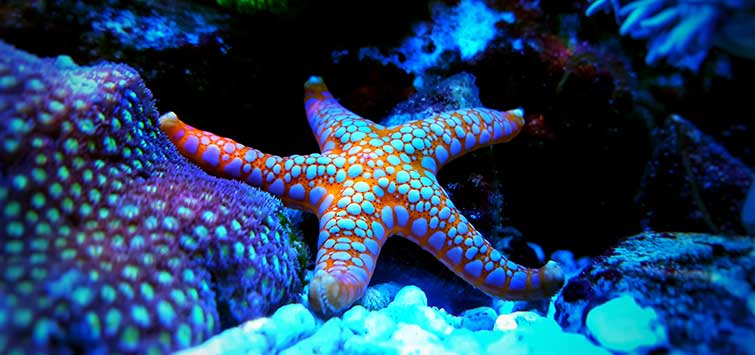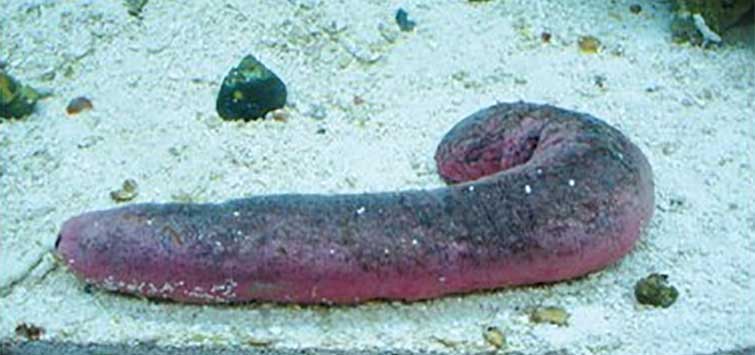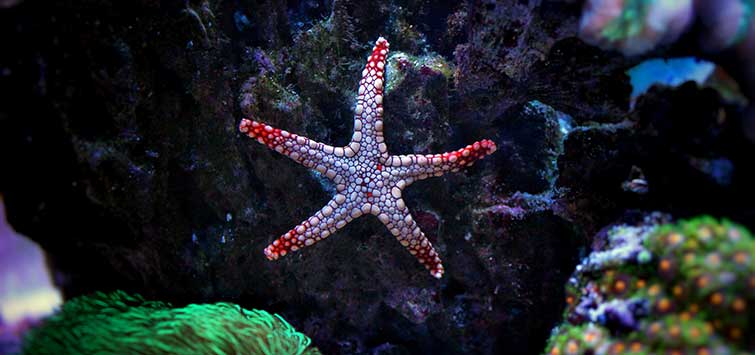Going Nano: Echinoderms: Sea Stars, Brittle Stars, Sea Lilies, and Sea Cukes for Small Marine Systems
Author: Bob Fenner
Surprising to many people is just how many spiny-skinned animals make up rocky reef fauna. In fact, they are the determinant group of life to be found there. Careful observation, especially diving by night, will reveal just how important this group is. Indeed, it has been written that they are the animals in shallow to deeper seas that, to a large extent, decide what else lives there.
Though most species of sea stars, sea cucumbers, and crinoids get too large for the smallish systems in our purview here, there are quite a few suitable members that are periodically available to hobbyists.
Sea Stars of Small Size (and Use)
Smaller sea stars may work in some cases, although I’m not referring to sand-sifting stars here; they are just too efficient at cleaning up—eating—the fauna inhabiting the spaces between grains of substrate. They should really only be stocked, if used at all, in very large systems with deep beds of live sand.
Asterina Stars
Asterina stars, yes! This delightful genus hosts a myriad small and, at times, colorful (blues, greens, reds, etc.) species of small stars. They feed largely on algal films but may disturb other encrusting life if allowed to reproduce to high density, so keep the herd thinned.
My Favorite Genus: Fromia
What are we all looking for in livestock? We are looking for organisms that are attractive, interesting behaviorally, hardy and adaptable, readily available, and not too expensive. Among the asteroids, this translates best as members of the genus Fromia. These stars are gorgeously colored and marked, they’re out and about versus shy and retiring most of the time, they survive shipping and handling well, and they generally don’t cost the proverbial (sea star) arm or leg. Some good examples are F. indica, F. milleporella, F. monilis, and F. nodosa.
Brittle Stars: Fabulous Little Cleaners
To heck with opportunistic omnivores like hermit crabs and mysterious and lazy non-cleaner-upper snails. My vote for best clean-up crew members goes to the small brittle stars. Sometimes you can buy these outright from your local fish store (LFS). Other times, if you can secure very healthy live rock, they may just “pop up” as hitchhikers. The systematics of small species and identification of small specimens is difficult. The best way to identify them is through image examples.
Stars to Avoid
You should take a pass on many asteroids. Too many of those offered in the trade are altogether unsuitable. They get too big, ship poorly, just die easily most of the time, or are predaceous. Some notable examples to pass up are members of the genus Linckia, which have a dismal survival history; the popular but short-lived chocolate chip star (Protoreaster nodosus); and the African or horned sea star (P. lincki), which is a predator of other sessile invertebrates.
A former darling, but blatant fish eater, the green (Deathstar!) serpent star (Ophiarachna incrassata) becomes too large for our consideration.
Frequently offered, Ophioderma rubicundum and O. squamosissima are good scavengers and reef-safe, but they are too large and hungry for small systems.
Gadzooks, Tiny Cukes!
Most holothuroids get way too big for 40-gallon (151-liter) or smaller tanks, and many of them have a nasty reflex defensive mechanism: their Cuvierian tubules, which are not only just ungodly sticky, but also toxic if released, resulting in the loss of all livestock. Stick with the non-toxic, small species.
One of the best choices is the yellow sea cucumber (Colochirus robustus), which grows to 4 inches (10 cm) in length. The red sea cucumber grows to a maximum length of about 3 inches (7.6 cm) and is a plankton feeder, requiring large refugium contributions and/or cultured materials (e.g., Artemia).
Beware This Destroyer of Worlds
I am both surprised and disappointed that the sea apple, or violet sea cucumber, is still sold in the trade. Pseudocolochirus violaceus and similar species can be deadly toxic if disturbed. They are sensitive to poor or changing water quality and are largely filter feeders. Avoid these.
Crinoids: Mysteries No More
Sea lilies, according to most hobby writers, are nearly impossible to keep in captivity. I assure you this is not the case. They are “sticky” to touch and, therefore, problematic to move. It’s best to gently prod them, or have them “walk up” net handles, and bag them underwater. Crinoids require seasoned (months-established) systems with other peaceful tankmates and some care in feeding (small materials, from a refugium or blended by you, fed with your mechanical filtration switched off). Look for a smallish specimen (3–4 inches [7.6–10 cm] in diameter) that’s been at your shop for a week or more. Pay attention to its size because they will shrink in time if undernourished. Crinoids occur in all colors of the rainbow, often two-tone.
No Urchins for You!
There are some small species of echinoids, of a few inches test diameter, but these rarely show up in the trade. The non-spiny (slate, pencil) urchins get too big and frequently starve, even in huge systems, and like their pin-cushioned cousins, they can push landscape over. If some small individuals show up on your live rock, so be it, but I would not buy them for stocking.
Asthenosoma varium is too toxic, Diadema antillarum is too spiky, and the pencil/slate urchin, Heterocentrotus mamillatus, is just too large.
Echinoderm Selection Criteria
1. Look carefully for blemishes, bulges, and other visible problems in the bodies of prospective purchases and those of other echinoderms in their system. Animals with such blemishes—missing arms or tube feet—rarely survive.
2. Select the more active individuals and ignore those “just sitting there.” Motility is a good indication of vitality.
3. Ask to have the animals fed in front of you. Even just some “food juice” added to an echinoderm’s system should elicit action and demonstrable activity.
4. Don’t buy “just arrived” specimens and never at “midnight madness” or “still in the bag” special sales. Most echinoderms die within a day of arrival at each step in the chain of custody. Let them rest before moving again.
Echinodermata is placed right next to Chordata—the phylum that includes the fishes and us. These are advanced organisms, and some smaller ones are suitable for aquariums of a few tens of gallons. They have similar needs for high, consistent water quality, a dearth of metabolites, and no measurable metal in their water. In moving them, do keep them submerged (trapped air in their bodies can be trouble). You may be fortunate enough to “inherit” spiny-skinned animals with your live rock, while others can make for attractive and useful introductions.
See the full article on TFH Digital http://www.tfhdigital.com/tfh/july_2014#pg37

.png?h=595&iar=0&w=2781&hash=5FD5E69473BCC22199FBFA2FB71B6033)



